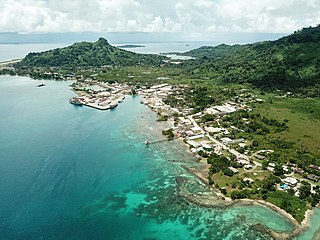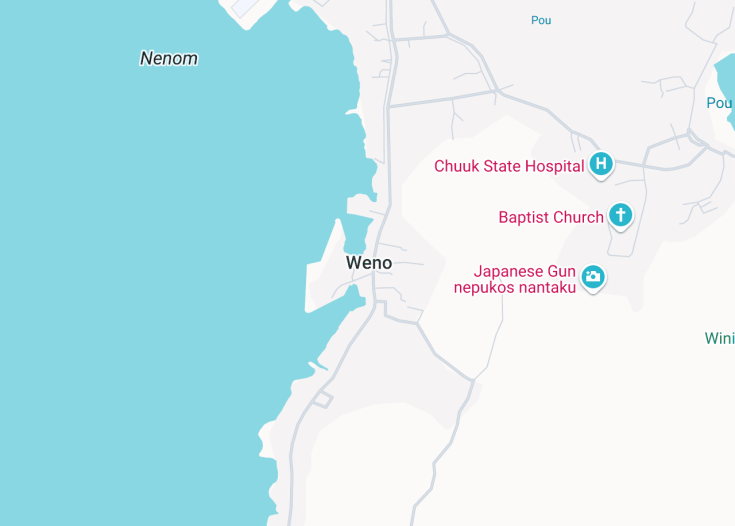Weno, the bustling capital of Chuuk State in the Federated States of Micronesia, offers a unique blend of natural beauty and rich history. This tropical paradise features lush landscapes, pristine beaches, and world-renowned diving spots with impressive shipwrecks from WWII. The island’s local culture, infused with a laid-back lifestyle and genuine hospitality, makes Weno an enticing destination for travelers seeking both adventure and relaxation.
Consider visiting Weno during the dry season from December to April for the best weather conditions to explore its natural and historical attractions.
Make sure to arrange your diving expeditions in advance, as the popular shipwreck sites often require reservations and certified diving guides.
Top things to do & see in Weno
Select the following sights and activities to discover best tickets and tours available in Weno.
Weno: Gateway to Serenity
| Country | Micronesia |
| Time in Weno | GMT+10 |
| Language spoken | Chuukese |
| Population | 13,856 (World Population Review) |
| Currency | United States Dollar (USD $) |
| Airports |
|
Weno is the largest of Chuuk State’s islands in the Federated States of Micronesia and serves as its commercial and government hub. Often considered the gateway to the Chuuk Lagoon, Weno is not only prominent for its role in regional governance but also esteemed for its rich history, especially during World War II. It is a treasure trove for divers worldwide, offering access to numerous underwater shipwrecks within one of the largest ship graveyards.
Historically, Weno has played a pivotal role during the Pacific Theatre of World War II, known for Operation Hailstone, a significant U.S. naval air and sea attack which caused considerable destruction to the then Japanese-held bastion. The remnants of the attack now give Weno its fame as a world-class destination for wreck diving. Numerous wartime relics lie sunken along the seabed, beautifully encrusted with marine life, attracting divers from across the globe.
Presently, Weno balances its historical allure with the demands of modernity. It hosts the state’s government offices, schools, healthcare facilities, and the Chuuk International Airport, facilitating the region’s connectivity. Its economic life pulsates from the central marketplace where local produce, crafts, and a vibrant community life depict the daily rhythm of island life. This market serves as a cultural melting pot, showcasing the rich traditions and the warm, welcoming nature of the Micronesian people.
The island’s infrastructure, though modest by international standards, is equipped to meet the basics for tourists and the local populace. There’s an observable push towards improving these facilities, reflective of Micronesia’s broader goals towards sustainable development and tourism, which remains a significant part of Weno’s local economy.
Where is Weno?
Weno Island is situated in the central Pacific Ocean, part of the Caroline Islands which are in the Federated States of Micronesia’s Chuuk State.
Distances:
| Route | Distance by car | Time by car |
|---|---|---|
| Weno to Chuuk International Airport | 2 miles | 5 minutes |
What is Weno famous for?
Weno is most famous as a prime destination for wreck diving, thanks to its numerous sunken ships and aircraft from World War II, all preserved in the coral-encrusted depths of Chuuk Lagoon.
History
Pre-20th Century
The history of Weno, an island in the Federated States of Micronesia, has its beginnings woven into the vast fabric of Micronesian culture. Originally settled by navigators from Southeast Asia over 4,000 years ago, Weno evolved through a series of complex sociopolitical developments. The indigenous Chuukese people, known for their intricate clan relationships and matrilineal society, dominated these islands.
20th Century – World War II
The 20th century marked significant upheavals for Weno as external powers took interest in the strategic benefits of the Micronesian islands. During World War II, Weno became a site of considerable military importance. Japanese forces fortified the island, constructing extensive bunkers, airstrips, and naval bases.
Post-World War II to Present
After the war, under United Nations’ trusteeship administered by the United States, Weno and the broader region of Chuuk underwent significant social and economic transformations. The shift towards self-governance culminated in 1979 with the establishment of the Federated States of Micronesia. Today, Weno thrives as a central hub, balancing modernity with its rich historical heritage and traditional practices.
Visit Weno
Highlights of Weno
Exploring Weno offers a unique glimpse into Micronesian culture intertwined with breathtaking natural beauty. Key attractions include the Chuuk Lagoon, renowned for its world-class diving spots riddled with sunken wartime relics. Meanwhile, the lush mountainous landscapes provide perfect trails for hiking enthusiasts. For those interested in local culture, the traditional village setups are a must-see.
- Chuuk Lagoon – Scuba diving
- Mountain Trails – Hiking
- Local Villages – Cultural experiences
Festive Weno
Weno’s calendar is dotted with colorful and vibrant festivities that reflect its rich cultural tapestry. Notably, the Chuuk Lagoon Festival, held annually in April, offers a series of canoe races, traditional dance displays, and local crafts exhibitions, drawing both locals and tourists alike.
Best time to visit Weno
The ideal time to visit Weno is during the dry months from December to April. This period offers optimal weather conditions for both diving and exploring the island’s lush landscapes, ensuring a pleasant and fulfilling travel experience.
Is Weno worth visiting?
Weno presents a compelling destination for those intrigued by rich historical narratives and pristine natural environments. The blend of World War II history, vibrant marine life, and traditional Micronesian culture makes it a unique spot in the Pacific. However, visitors should be prepared for a relatively undeveloped tourism infrastructure, which can be part of its charm or a challenge, depending on one’s preferences. For adventure seekers and cultural enthusiasts, Weno is undoubtedly worth the journey.












